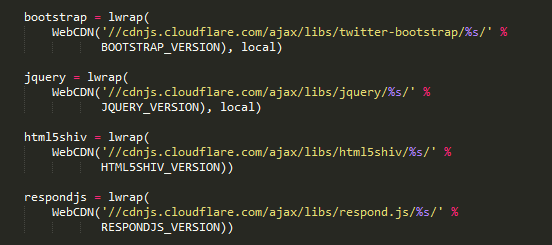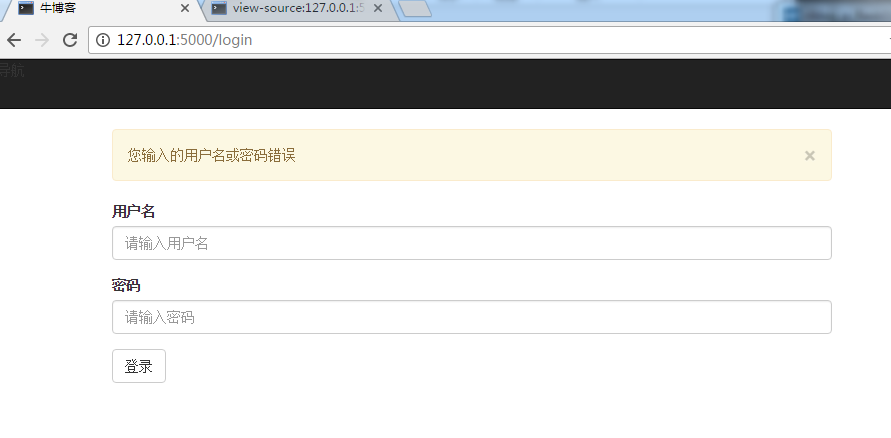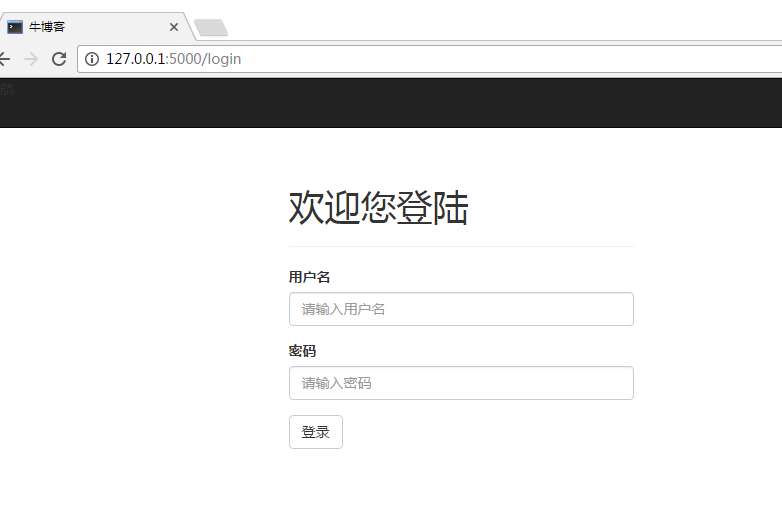经过上一章的内容,其实就页面层来说已结可以很轻松的实现功能了,但是很明显美观上还有很大的欠缺,现在有一些很好的前端css框架,如AmazeUI,腾讯的WeUI等等,这里推荐一个和flask集成很好的bootstrap框架
安装框架
在模板中直接引用bootstrap的CDN或者本地路径外,还可以直接应用flask的bootstrap集成包,首先需要对集成包进行安装:
pip3.6 install flask-bootstrap
这是一个flask的扩展包,flask的所有扩展包默认默认的包名都为flask.ext打头,同样bootstrap也是如此,首先在default的文件的头部导入包:
from flask.ext.bootstrap import Bootstrap
然后对bootstrap进行初始化,修改代码:
bootstrap=Bootstrap(app)
初始化之后,就可以使用Jinja2的继承方式使用此包中的包含的一系列的针对Bootstrap的基模板。基模板中直接引用了一系列的bootstrap中的元素。
还记得如何在jinja2中使用模板继承吧,下面在使用之前,首先看看基模板的结构:
|
1
2
3
4
5
6
7
8
9
10
11
12
13
14
15
16
17
18
19
20
21
22
23
24
25
26
27
28
29
30
31
32
33
34
|
{% block doc -%}<!DOCTYPE html><html{% block html_attribs %}{% endblock html_attribs %}>{%- block html %} <head> {%- block head %} <title>{% block title %}{{title|default}}{% endblock title %}</title> {%- block metas %} <meta name="viewport" content="width=device-width, initial-scale=1.0"> {%- endblock metas %} {%- block styles %} <!-- Bootstrap --> <link href="{{bootstrap_find_resource('css/bootstrap.css', cdn='bootstrap')}}" rel="external nofollow" rel="stylesheet"> {%- endblock styles %} {%- endblock head %} </head> <body{% block body_attribs %}{% endblock body_attribs %}> {% block body -%} {% block navbar %} {%- endblock navbar %} {% block content -%} {%- endblock content %} {% block scripts %} <script src="{{bootstrap_find_resource('jquery.js', cdn='jquery')}}"></script> <script src="{{bootstrap_find_resource('js/bootstrap.js', cdn='bootstrap')}}"></script> {%- endblock scripts %} {%- endblock body %} </body>{%- endblock html %}</html>{% endblock doc -%} |
从源码中可以看出,这个基模板定义了12个block,分别对应了整个文档(doc),html属性(html_attribs),整个html(html),整个head部分(head),title部分(title),meta代码部分(metas),css样式(styles),body属性(body_attribs),body部分(body),导航(navbar),
页面内容(content),js(scripts)
并且title,meta,css,和js均有默认的内容,所以使用的时候需要加入{{super()}}
好,根据这个基模板的结构,修改login.html中的代码为:
|
1
2
3
4
5
6
7
8
9
10
11
12
13
14
15
16
17
18
19
20
21
22
23
24
25
26
|
{% extends "bootstrap/base.html"%}{% block title%}牛博客 {% endblock %}<!--覆盖title标签-->{% block navbar %}<nav class="navbar navbar-inverse"><!-- 导航部分 --> 导航</nav>{% endblock %}{% block content %} <!--具体内容--><div class="container"> <div class="container"> <form method="post"> <div class="form-group"> <label for="username">用户名</label> <input type="text" class="form-control" id="username" placeholder="请输入用户名"> </div> <div class="form-group"> <label for="passworld">密码</label> <input type="password" class="form-control" id="passworld" placeholder="请输入密码"> </div> <button type="submit" class="btn btn-default">登录</button> </form> </div></div>{% endblock %} |
运行程序,现在的显示结果为:

比刚刚漂亮多了,这时生成的html代码为:
|
1
2
3
4
5
6
7
8
9
10
11
12
13
14
15
16
17
18
19
20
21
22
23
24
25
26
27
28
29
30
|
<!DOCTYPE html><html> <head> <title>牛博客 </title> <meta name="viewport" content="width=device-width, initial-scale=1.0"> <!-- Bootstrap --> <link href="//cdnjs.cloudflare.com/ajax/libs/twitter-bootstrap/3.3.7/css/bootstrap.min.css" rel="external nofollow" rel="external nofollow" rel="stylesheet"> </head> <body> <nav class="navbar navbar-inverse"><!-- 导航部分 --> 导航 </nav> <!--具体内容--> <div class="container"> <form method="post"> <div class="form-group"> <label for="username">用户名</label> <input type="text" class="form-control" id="username" placeholder="请输入用户名"> </div> <div class="form-group"> <label for="passworld">密码</label> <input type="password" class="form-control" id="passworld" placeholder="请输入密码"> </div> <button type="submit" class="btn btn-default">登录</button> </form> </div> <script src="//cdnjs.cloudflare.com/ajax/libs/jquery/1.12.4/jquery.min.js"></script> <script src="//cdnjs.cloudflare.com/ajax/libs/twitter-bootstrap/3.3.7/js/bootstrap.min.js"></script> </body></html> |
注意这几个cdn的地址,这个地址有时候会被挡在墙外,这时怎么办呢?
修改的方式为在python的安装目录下找到Libsite-packages lask_bootstrap文件夹,文件夹下有__init__.py文件,打开后看到如下代码:

进行修改,顺便提一下,我比较常使用bootcdn这个cdn服务器
下面使用土法进行一下测试,输入test和123后的结果为:

显示的还是之前的测试登录成功页,这显然是不对的,一般来说,bbs或blog都是跳到登录前的页面或者首页,现在为了方便起见,都跳转到首页,同时,如果用户名或密码错误,也要在登录页进行提示,修改default.py代码如下:
|
1
2
3
4
5
6
7
8
9
10
11
|
from flask import session #导入session对象@app.route("/login",methods=["POST"])def loginPost(): username=request.form.get("username","") password=request.form.get("password","") if username=="test" and password=="123" : session["user"]=username return render_template("/index.html",name=username,site_name='myblog') else: return "登录失败" |
登录成功后的源码为:
|
1
2
3
4
5
6
7
8
9
10
|
<!DOCTYPE html><html><head> <meta charset="UTF-8"> <title>myblog</title></head><body><h1>这个站点的名字为 myblog </h1></body></html> |
哦,对了,没有引用bootstrap的基模板,修改index.html的模板代码,将第一行的
{% extends "base.html" %}
修改为
{% extends "bootstrap/base.html" %}
刷新为:
|
1
2
3
4
5
6
7
8
9
10
11
12
|
<!DOCTYPE html><html> <head> <title>blog</title> <meta name="viewport" content="width=device-width, initial-scale=1.0"> <!-- Bootstrap --> <link href="//cdnjs.cloudflare.com/ajax/libs/twitter-bootstrap/3.3.7/css/bootstrap.min.css" rel="stylesheet"> </head> <body> <h1>这个站点的名字为 myblog </h1> </body></html> |
看到已经成功引用了bootstrap框架,但是导航部分全部都没有,这时当然不能在写一遍导航,直接修改自定义的基模板,然后让其他模板引用即可,修改基模板为:
|
1
2
3
4
5
6
7
8
9
10
11
12
|
{%extends "bootstrap/base.html "%}{% block title%}牛博客 {% endblock %}<!--覆盖title标签-->{% block navbar %}<nav class="navbar navbar-inverse"><!-- 导航部分 --> 导航</nav>{% endblock %}{% block content %} <!--具体内容--><div class="container"></div>{% endblock %} |
然后修改首页代码:
|
1
2
3
4
5
|
{% extends "base.html" %}{% block content %} <h1>这个站点的名字为 {{site_name}} </h1>{% endblock %} |
修改登录页代码为:
|
1
2
3
4
5
6
7
8
9
10
11
12
13
14
15
16
|
{% extends "base.html"%}{% block content %} <!--具体内容--><div class="container"> <form method="post"> <div class="form-group"> <label for="username">用户名</label> <input type="text" class="form-control" name="username" id="username" placeholder="请输入用户名"> </div> <div class="form-group"> <label for="passworld">密码</label> <input type="password" class="form-control" name="password" id="passworld" placeholder="请输入密码"> </div> <button type="submit" class="btn btn-default">登录</button> </form></div>{% endblock %} |
下面登录成功页的显示结果为:

页面风格与登录页保持了一致,但是,目前还是如果用户名密码错误(即输入的不是test和123),那么除了和刚刚一样返回一个登录错误的字符串之外,用户是无法获悉的,就需要一个反应用户状态的方法,这一点,flask提供了flash函数,下面继续修改default.py文件:
|
1
2
3
4
5
6
7
8
9
10
11
12
|
from flask import flash@app.route("/login",methods=["POST"])def loginPost(): username=request.form.get("username","") password=request.form.get("password","") if username=="test" and password=="123" : session["user"]=username return render_template("/index.html",name=username,site_name='myblog') else: flash("您输入的用户名或密码错误") return render_template("/login.html") #返回的仍为登录页 |
修改login.html模板:
|
1
2
3
4
5
6
7
8
9
10
11
12
13
14
15
16
17
18
19
20
21
22
23
24
|
{% extends "base.html"%}{% block content %} <!--具体内容--><div class="container"> {% for message in get_flashed_messages() %} <div class="alert alert-warning"> <button type="button" class="close" data-dismiss="alter">×</button> {{message}} </div> {% endfor %} <form method="post"> <div class="form-group"> <label for="username">用户名</label> <input type="text" class="form-control" name="username" id="username" placeholder="请输入用户名"> </div> <div class="form-group"> <label for="passworld">密码</label> <input type="password" class="form-control" name="password" id="passworld" placeholder="请输入密码"> </div> <button type="submit" class="btn btn-default">登录</button> </form></div>{% endblock %} |
好下面输入test和1234,显示结果为:

状态很完美的显示出来。
继续美化
登录的页面和控制器的基本功能都已经完成,但是仅仅就现在这个页面来说,没有登录框占整个屏幕的,一般来说,都是居中的一部分,这块不涉及flask的部分,轮到bootstrap的栅格系统登场了。
栅格系统简单说就是将一个container或container-fluid中分为12个列,每个列都可以合并或偏移,与html中的table类似,并且支持响应式,通过xs,sm,md,lg来进行不同屏幕尺寸的区分。下面用栅格系统对登录页进行一下修改:
|
1
2
3
4
5
6
7
8
9
10
11
12
13
14
15
16
17
18
19
20
21
22
23
24
25
26
27
28
29
30
31
32
|
{% extends "base.html"%}{% block content %} <!--具体内容--><div class="container"> <div class="row"></div> <div class="row"> <#-- col-md-4表示合并4列,col-md-offset-4表示偏移4列 sm意思相同 --#> <div class="col-md-4 col-md-offset-4 col-sm-6 col-sm-offset-3"> <div class="page-header"> <h1>欢迎您登陆</h1> </div> {% for message in get_flashed_messages() %} <div class="alert alert-warning"> <button type="button" class="close" data-dismiss="alter">×</button> {{message}} </div> {% endfor %} <form method="post"> <div class="form-group"> <label for="username">用户名</label> <input type="text" class="form-control" name="username" id="username" placeholder="请输入用户名"> </div> <div class="form-group"> <label for="passworld">密码</label> <input type="password" class="form-control" name="password" id="passworld" placeholder="请输入密码"> </div> <button type="submit" class="btn btn-default">登录</button> </form> </div> </div></div>{% endblock %} |
显示结果如下:

毕竟不是专业美工,没有经过设计,但至少比刚刚美观多了,但登录的用户名和密码写成固定值肯定是不行的,数据库是必不可少的,将在下一章让flask和mysql进行互联。
以上就是本文的全部内容,希望对大家的学习有所帮助,也希望大家多多支持服务器之家。










